Southern Ocean Adventure

Oriole
Fri 27 Dec 2013 21:42
Sunday 17th November - Sunday 7th December
2013. Falkland Islands, South Georgia, Elephant Island,
South Shetland Islands and the Antarctic Peninsula
Eighteen Day expedition cruise on the Akademik
Ioffe.

Akademik Ioffe
Buenos Aires, Argentina.
On our way to join our ship in
Ushuaia we stopped off for a couple of nights in Buenos Aires. Early on Sunday
morning within two hours of arriving, while sitting in a quiet café, Chris
had her bag containing her passport stolen in such a clandestine way that we
have no idea quite how it happened. The UK Embassy and the local police
who are well used to this scenario were extremely helpful and by midday on
Monday an emergency passport was issued and the application for a full
replacement was on its way to the Passport Office in Durham.
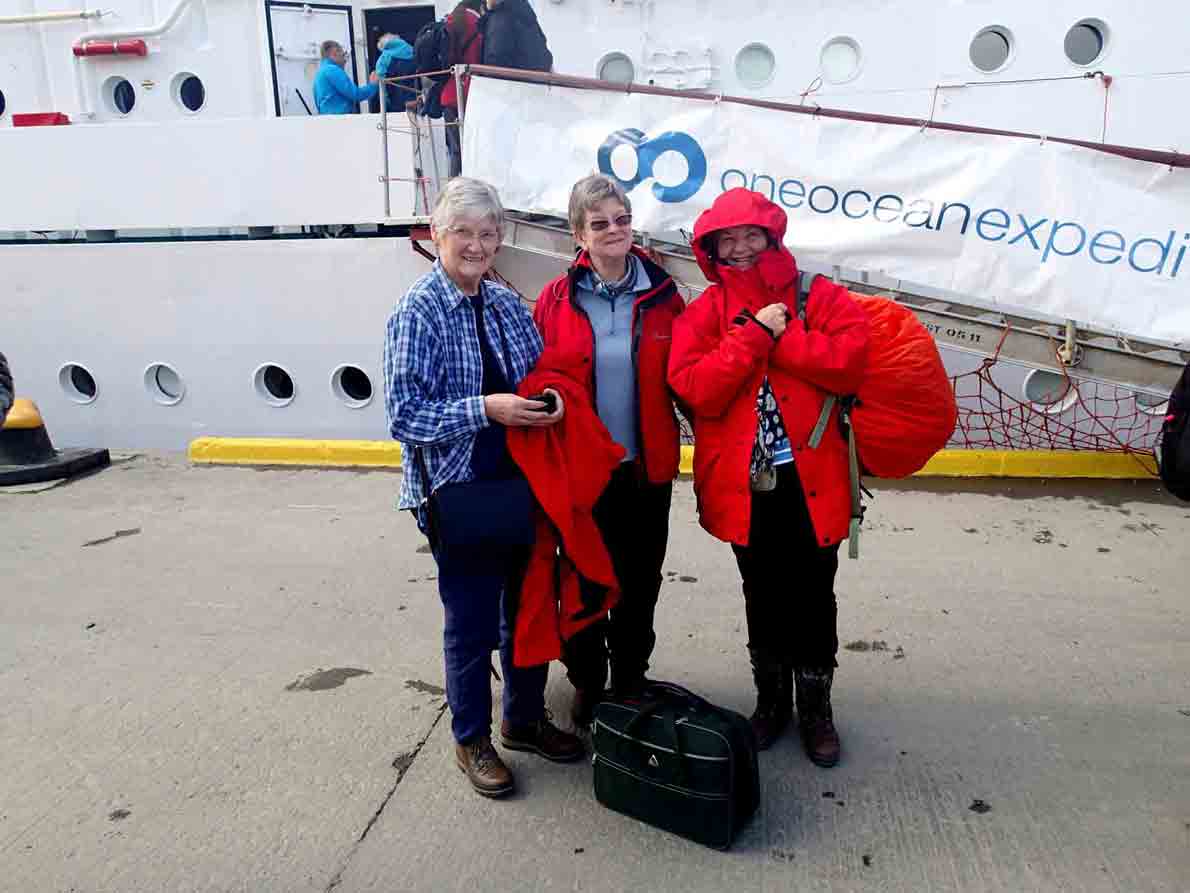
Edith, Liz and Chris.
Ushuaia, Argentina.
We flew into Ushuaia, the capital of
Tierra del Fuego on Tuesday evening, meeting up with John's sister Liz and her
friend Edith. When we looked out of our hotel window the next morning
it was snowing heavily right down to sea level. If we had not
realised already that we were in for some seriously cold weather, we
certainly appreciated it now. We made a few additional thermal purchases
from the myriad climbing, hiking and mountaineering shops and joined the ship in
the late afternoon. The Akademik Ioffe is one of two sister ships built in
Finland for a Russian Oceanographic Institute 25 years ago, just as the Cold War
was coming to an end. They were undoubtedly submarine spy ships and are
still equipped with enormous and extremely sophisticated sonar transmitters and
receivers. For Arctic and Antarctic Cruises both ships are chartered to
One Ocean, a Canadian expedition company and when not chartered do
"research". Of a maximum 96 passengers we were fortunate to have only
60, and with 25 One Ocean staff we were well looked after. Almost as
soon as we were aboard the lines were slipped and we were off down the Beagle
Channel on a beautiful clear evening. Being a spy ship the sound
insulation is extraordinarily good and we were initially unaware of our getting
underway. With bow thrusters and stern thrusters, the 350 foot ice
strengthened Ioffe is extremely manoeuvrable.
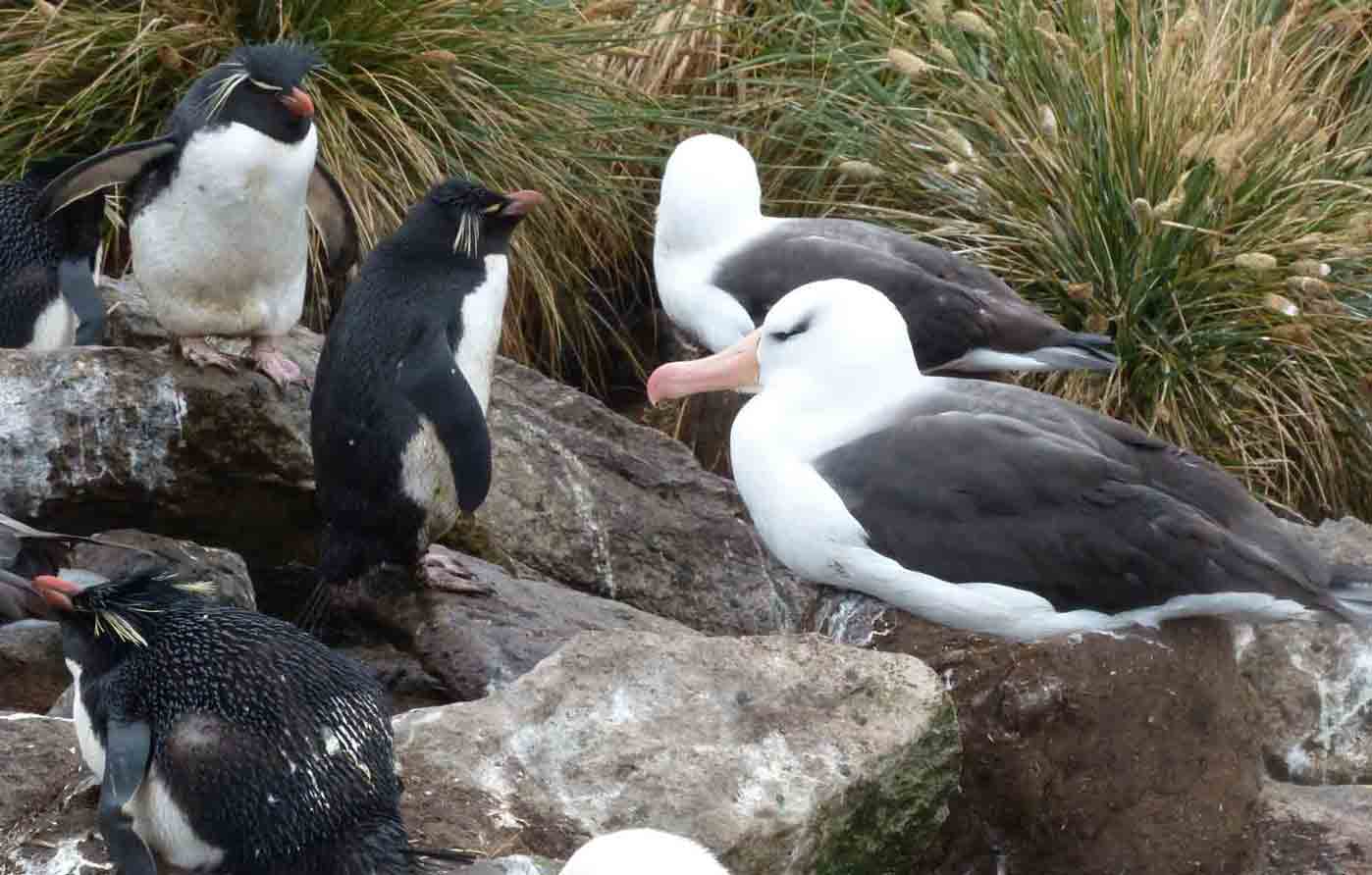
Black Browed Albatross and Rockhopper
Penguins, West Falkland.

Gentoo Penguins Wesrt
Falkland.
Falkland Islands.
After 36 hours at sea, our first stop
was at anchor at West Point Island off West Falkland where we landed
and walked to a Black Browed Albatross and Rockhopper Penguin nesting site,
where we were able to get within a few feet of the birds. The ship is
equipped with 10 Zodiac inflatables powered by 50h-p outboards each taking up to
twelve passengers. These were launched and recovered with amazing speed
and we were whisked around with great efficiency, and were well protected
from the spray and cold with bright red oilskins and excellent rubber
boots. While we were lunching in the dining room the ship moved to our
next site on Saunders Island where Rockhopper, Gentoo, Magellanic
and Macaroni Penguins were nesting around a beautiful beach where we
also had our first introduction to the stately King Penguins whose
young from last year were still shedding their brown fluffy protection.
Another excellent meal ensued which emphasised the gastronomic pattern of
the rest of the trip while we moved towards Stanley for the following day.
If anywhere is Little England this is it. The natives speak an accentless
English, Land Rovers are the preferred means of transport, and with no tax
and only £2000 transport costs, are very cheap. The appearance of the Falklands
and Stanley is very reminiscent of a Hebridean Island, with the exception
of the smart Government House. There are still many remnants of the
Falklands War with most of the minefields still remaining and the
large dock, where we tied, being the temporary arrangement after the
Argentinians were removed. The superb museum is a great source of
information of all things Falklandian, of both of war and peace.
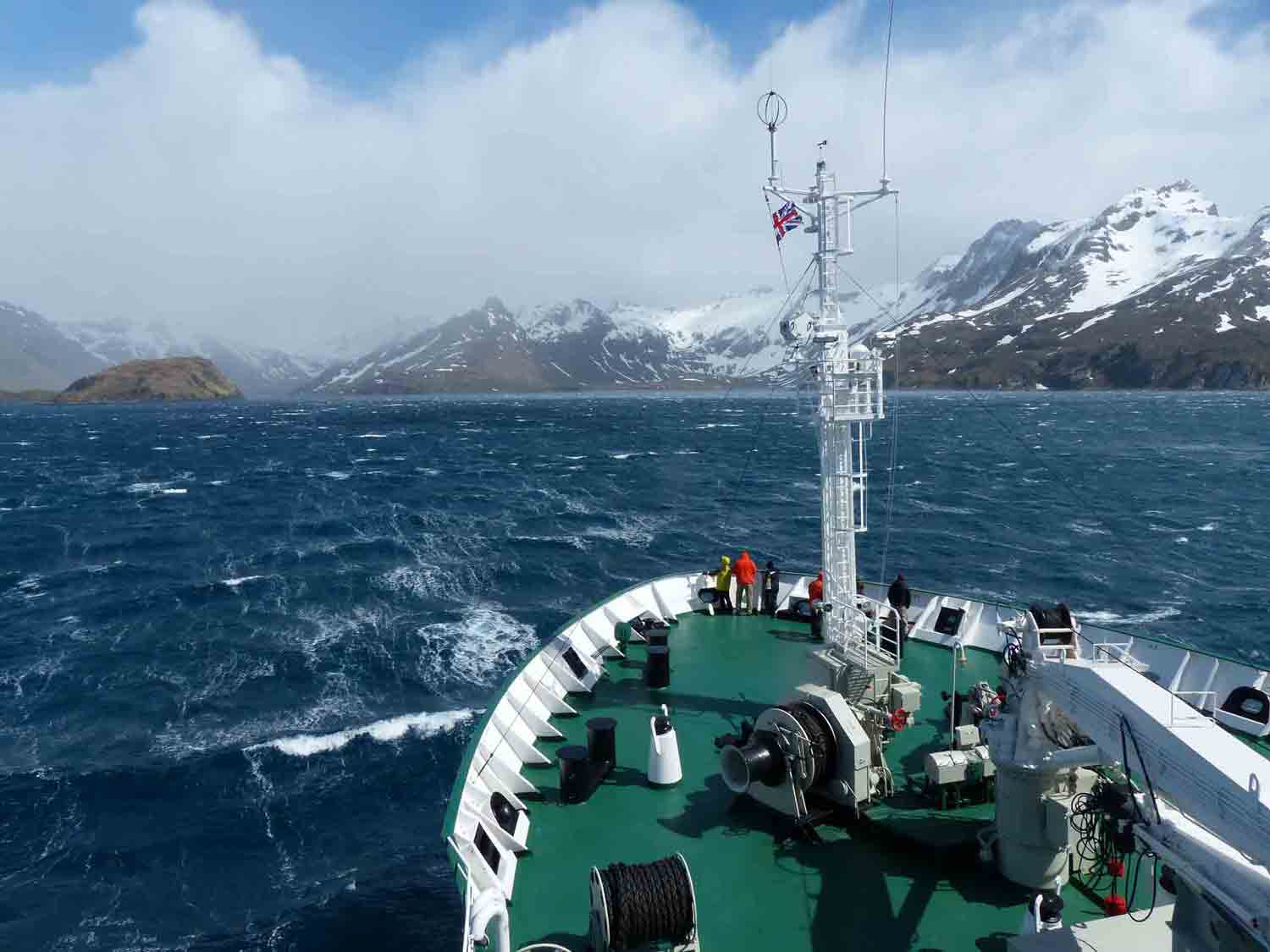
Entering Stromness Harbour, South
Georgia.
South Georgia
We steamed out through the narrow
entrance of Stanley Harbour in the evening and there followed two complete days
and three nights at sea heading for South Georgia 750 nautical miles
away. The sea and the sky were grey, the sea pretty rough but comfortably
from astern with a few birds and occasional whale spouts for company.
However we had not a spare moment. We had some superb lectures on a
multitude of Antarctic related subjects from the very well informed and
dedicated One Ocean crew, and one delicious meal was quickly followed by
another. The 40 strong ships crew are all Russian and we were
impressed by their seamanship. The bridge was open almost all the time and
the rather austere and formal Russian officers eventually melted and became
very friendly. We awoke on Tuesday morning to see the snow covered
mountains of South Georgia rising from the sea kicked into a frenzy by
a full gale. We entered Stromness Harbour, where the rusty
buildings of the Whaling Station into which Sir Ernest
Shackleton eventually staggered after climbing over the mountains from his
landing place on the south side of the island. He had sailed and rowed
all the way from the ice edge of Antarctica via Elephant Island in small boats
having lost his ship Endurance in the ice. The wind for us was a
steady 55 knots and the surface of the sea was whipped into spray from the
catabatic gusts coming down off the glaciers and snow covered
mountains. We moved on to a relatively calm anchorage in Grytviken where
there is another old whaling station and a British Antarctic Survey Base, and
also the seat of the South Georgia Government, (all two of
them). Once we were cleared Customs and Immigration and our boots and
oilskins inspected for foreign material (mud, seeds etc) we were allowed
ashore where our first stop was to the graves of Shackleton and Wild (his
right hand man) where we toasted the Boss and poured a little whisky on the
graves.
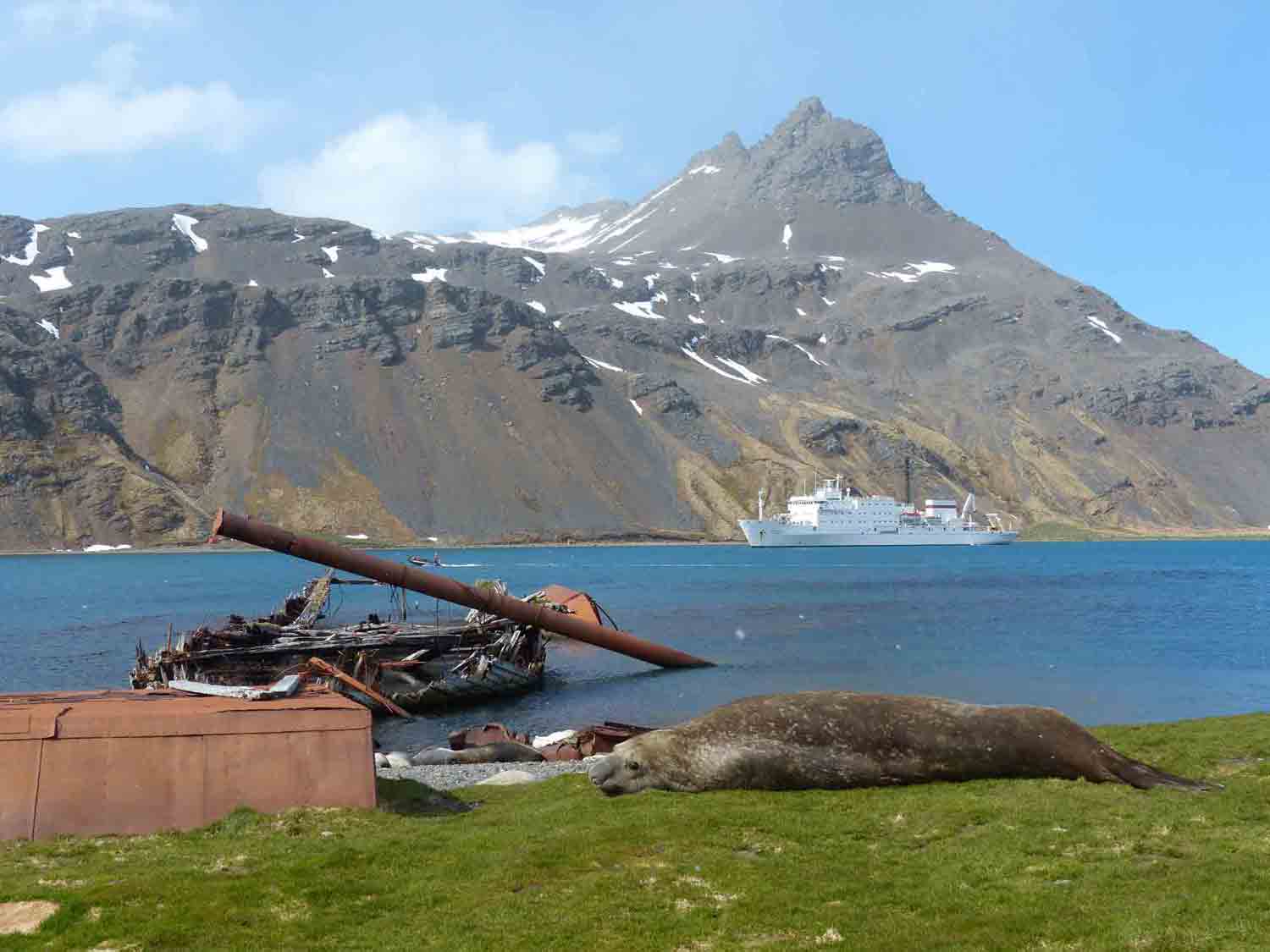
Grytviken, with Ioffe, a wrecked whale
catcher and a sleepy bull elephant seal.

Toasting the Boss.
Exercise in the hills followed after
a guided tour of the old factory, avoiding the fur seals and elephant seals on
the beach. Sadly this did not leave half enough time for the
excellent museum set up by Tim and Pauline Carr RCC who sailed here and
lived in their engineless Falmouth Quay Punt Curlew. The Government Officers
dined with us and were very interesting, we donated to the rat extermination
programme which is already showing signs of benefit to the wildlife, and as soon
as they had gone ashore we were underway again for our next destination.
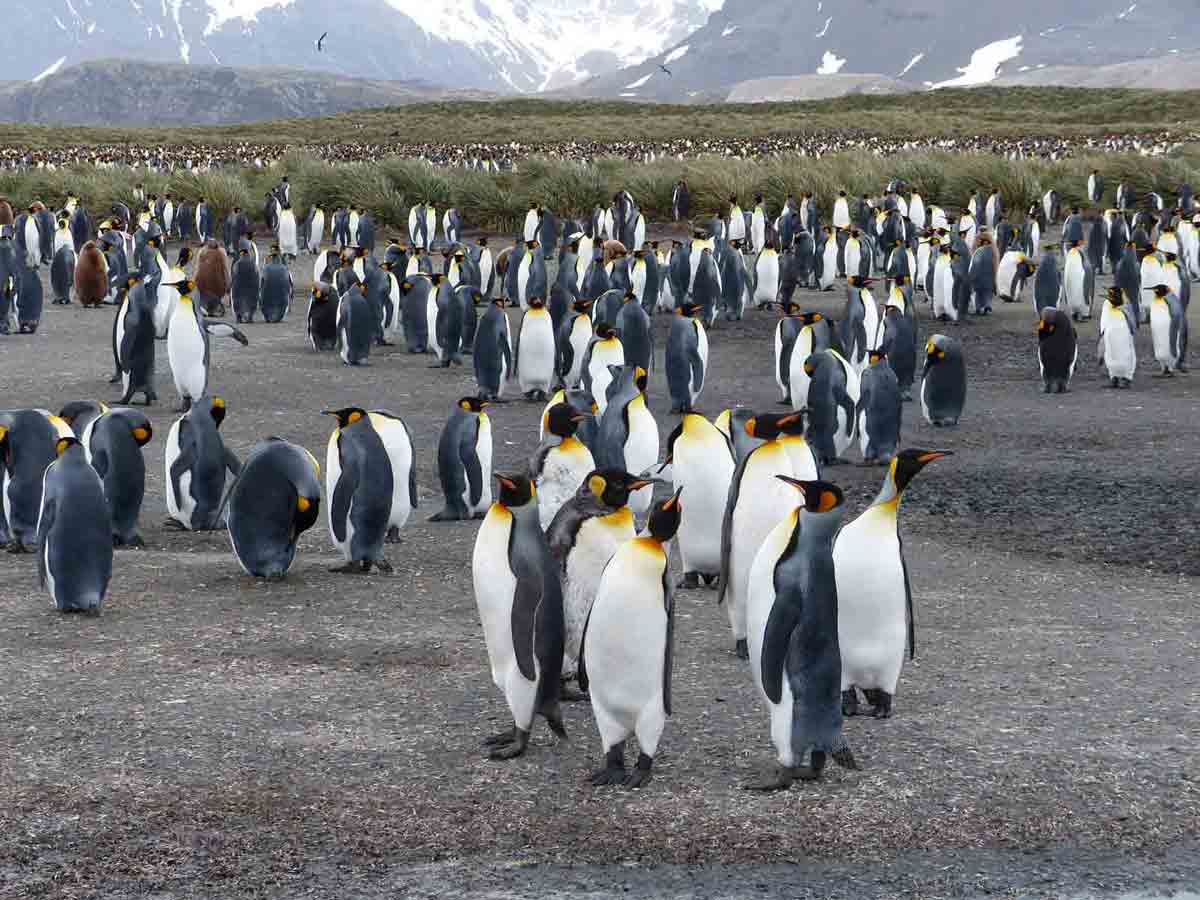
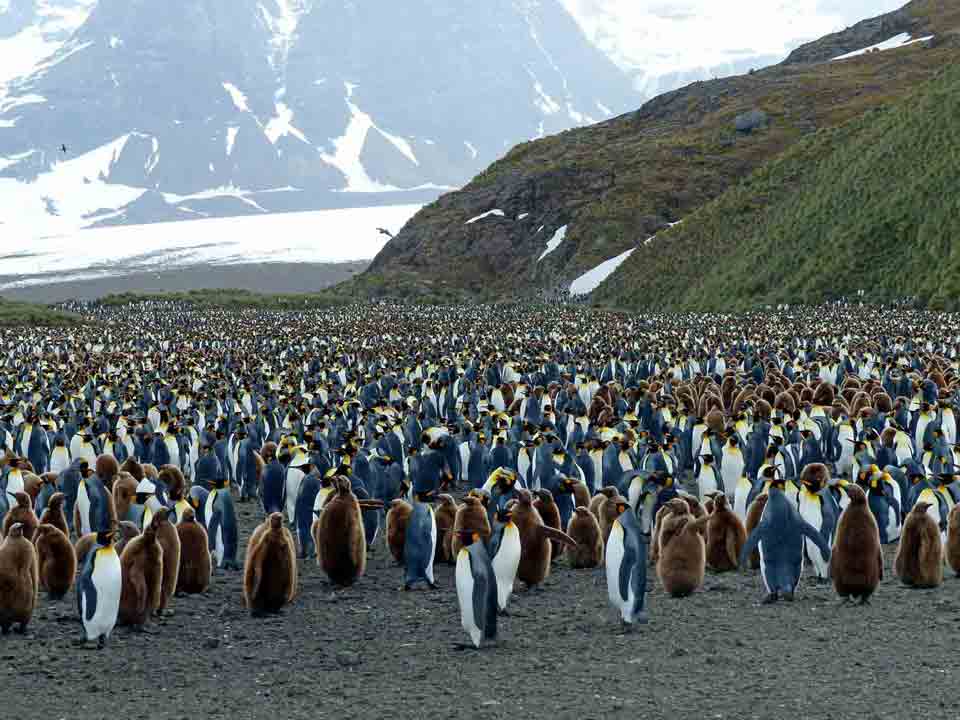
King Penguins South Georgia.
During the next two days we visited
three beach areas with thousands of mainly King Penguins with some pretty
aggressive Fur Seals and the much less aggressive sleepy Elephant Seals and
their delightful and friendly pups. The numbers of King Penguins, tens of
thousands, were truely staggering.

Two's company
...............................
Our visit culminated with the ship
going right to the top of Dragalski Fjord which has mountains and glaciers
falling steeply into the sea with our first experience of floating ice.
One medium sized tabular iceberg guarded the entrance and there were bergy
bits calving off the glaciers.
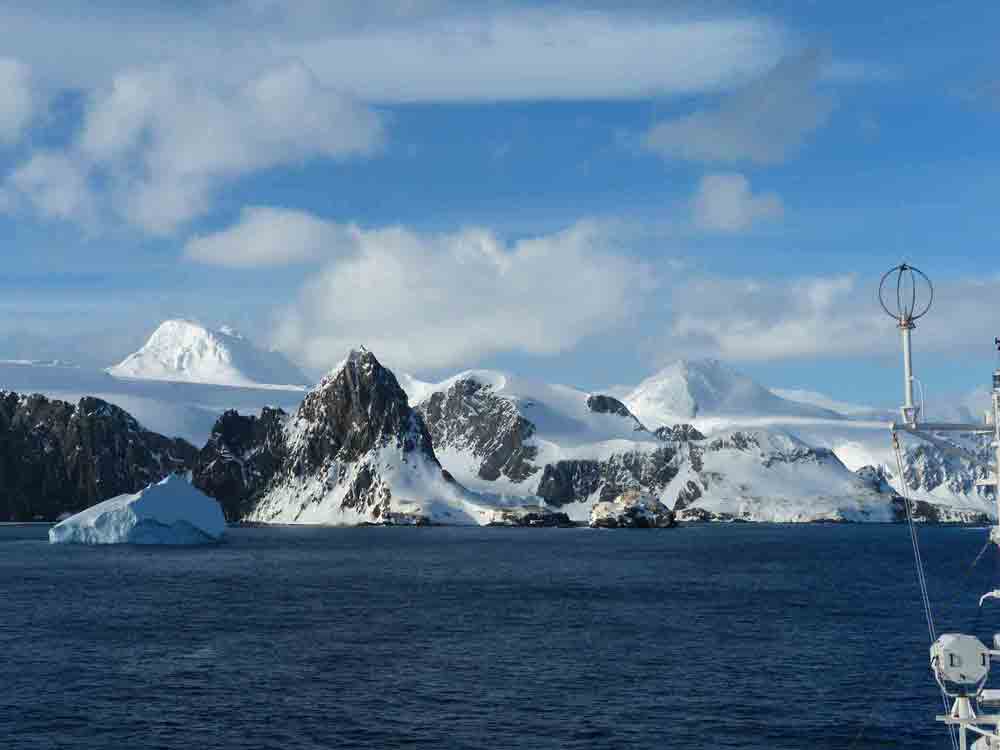
Point Wild, Elephant
Island.
Antarctic Peninsula.
Now that we had crossed the Antarctic
Convergence, a boundary between the relatively warm water (6C) to the north and
the colder water (2C) to the south, there were more birds: mainly masses of the
very pretty Cape Petrels with fewer equally pretty Antarctic Prions,
soaring and rather ugly Southern Giant Petrels, Albatrosses of various sorts and
the ubiquitous Wilson's Storm Petrel which we also get in home waters, and we
sighted more whales on our four day 700 nm passage to Elephant Island and the
start of the Peninsula. The wind was often at full gale force and with big
Southern Ocean swells into which we were ploughing, the ship was at
times slowed to 4 knots and if going any faster was shuddering from stem to
stern. This bit of the trip inevitably took a little longer than usual but
on the morning of the fourth day we sighted Elephant Island and in the lee
of Point Wild we managed to visit in the Zodiacs the beach where Shackleton
eventually landed his crew where they waited for three months while he sailed in
the diminutive James Caird for South Georgia. Here on the beach is a bust
to the memory of the skipper of the whaler which eventually broke through
the ice to rescue the men in what was now the depths of winter. Shackleton
lost not one man after Endurance was crushed in the ice. We got an
idea of what the conditions must have been like. Air temperature for us
was a lofty 1-2C and the sea temperature 1C, but the windchill was
stunning.
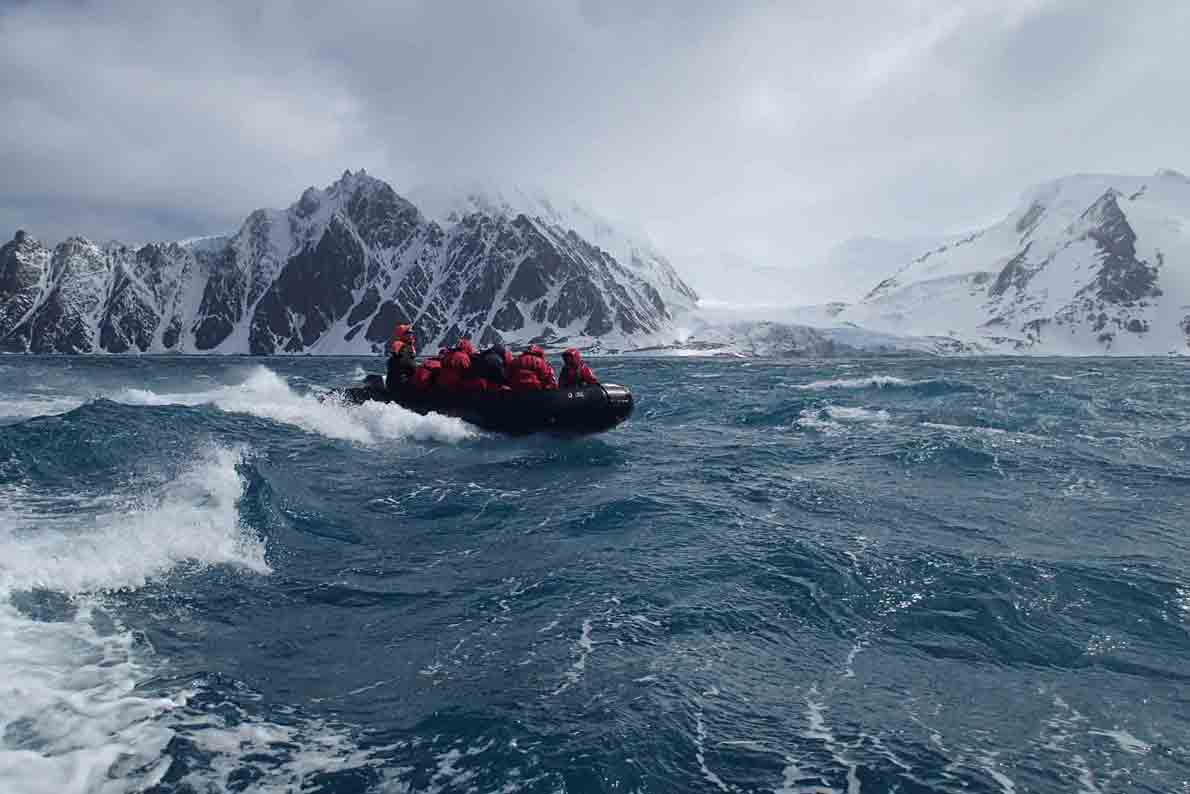
This Zodiac trip off Elephant Island
did cause some sense of humour failure.
We later took a Zodiac trip out to
Cape Lookout on the west end of the island where the initial landing had been
made and there were a number of our companions who had a complete sense of
humour failure. It was very rough, and very cold, but Chris and I
were well insulated and it was most exhilarating. Overnight we made
for Antarctic Sound where we landed at Brown Bluff on the Antarctic Mainland,
climbed the glacier, visited a nearby Argentine Research Station and then
approached the pack ice which was blocking the south east entrance to the Sound
which we had hoped to access.
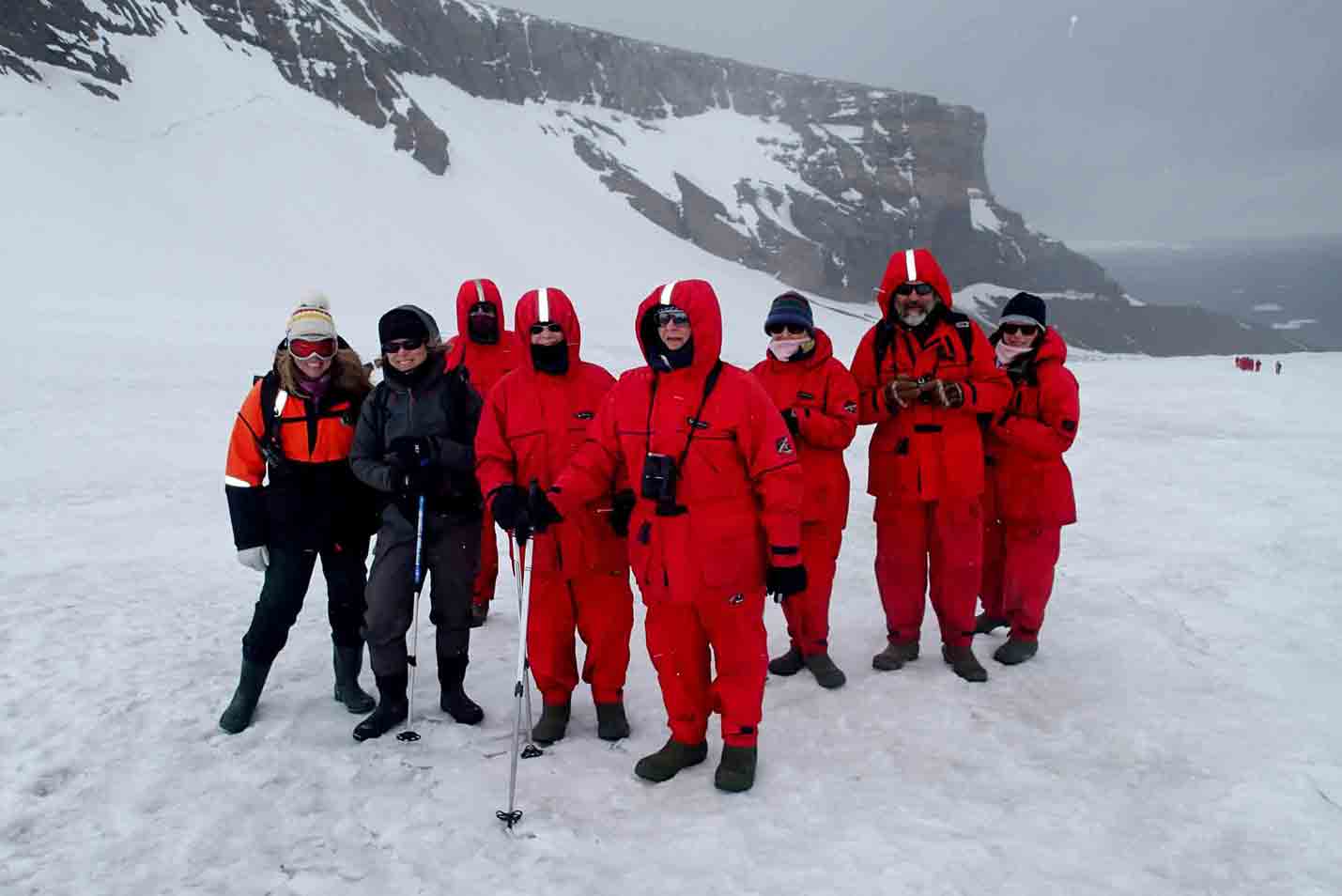
It was bitterly cold up on the
glacier at Brown Bluff.
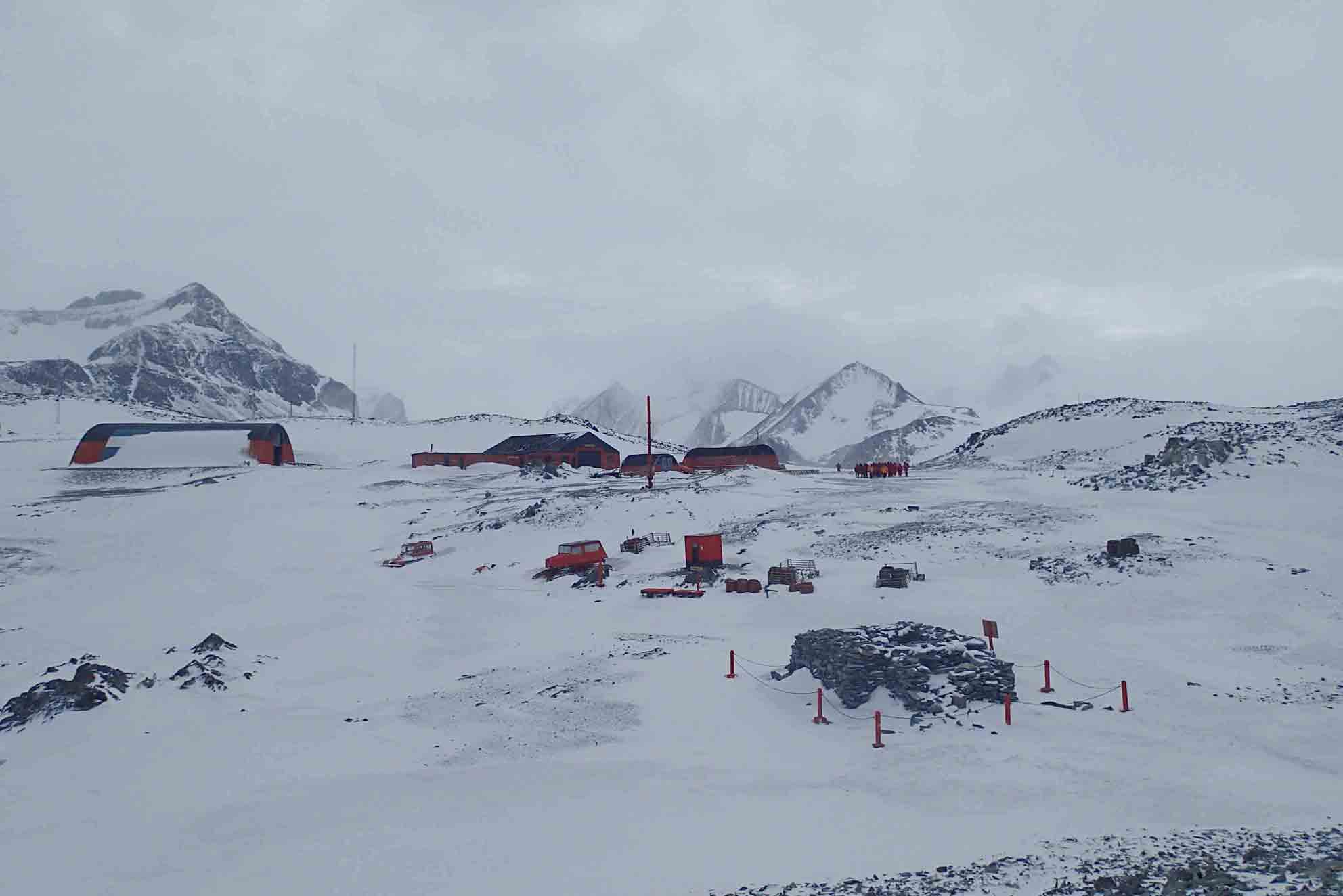
Am I being over suspicious of the
motives for bringing Argentinian families to this hostile environment for a
year or more?
However this gave us the opportunity
to visit the South Shetland Islands and Deception Island, an enormous and
spectacular flooded caldera where there used to be a British Antarctic
Survey Base. This had to be rapidly evacuated in the 70s when the volcano
erupted. On the way we visited Half Moon Island where Chin Strap Penguins were
nesting and bonking, of which I have graphic film strip! We spent the
evening in Deception Island's Port Foster, where after walking up to the recent
volcanic crater we had a magnificent BBQ on the stern deck, a memorable occasion
during which we just managed to survive the near freezing temperature. Back on
the southern side of Bransfield Strait by next morning we visited two
spectacular bays filled with the most beautiful sculptured icebergs on Trinity
Island and Cierva Cove on the Antarctic Mainland. There we spent many hours
cruising in the Zodiacs with our cameras in beautiful clear calm
weather.
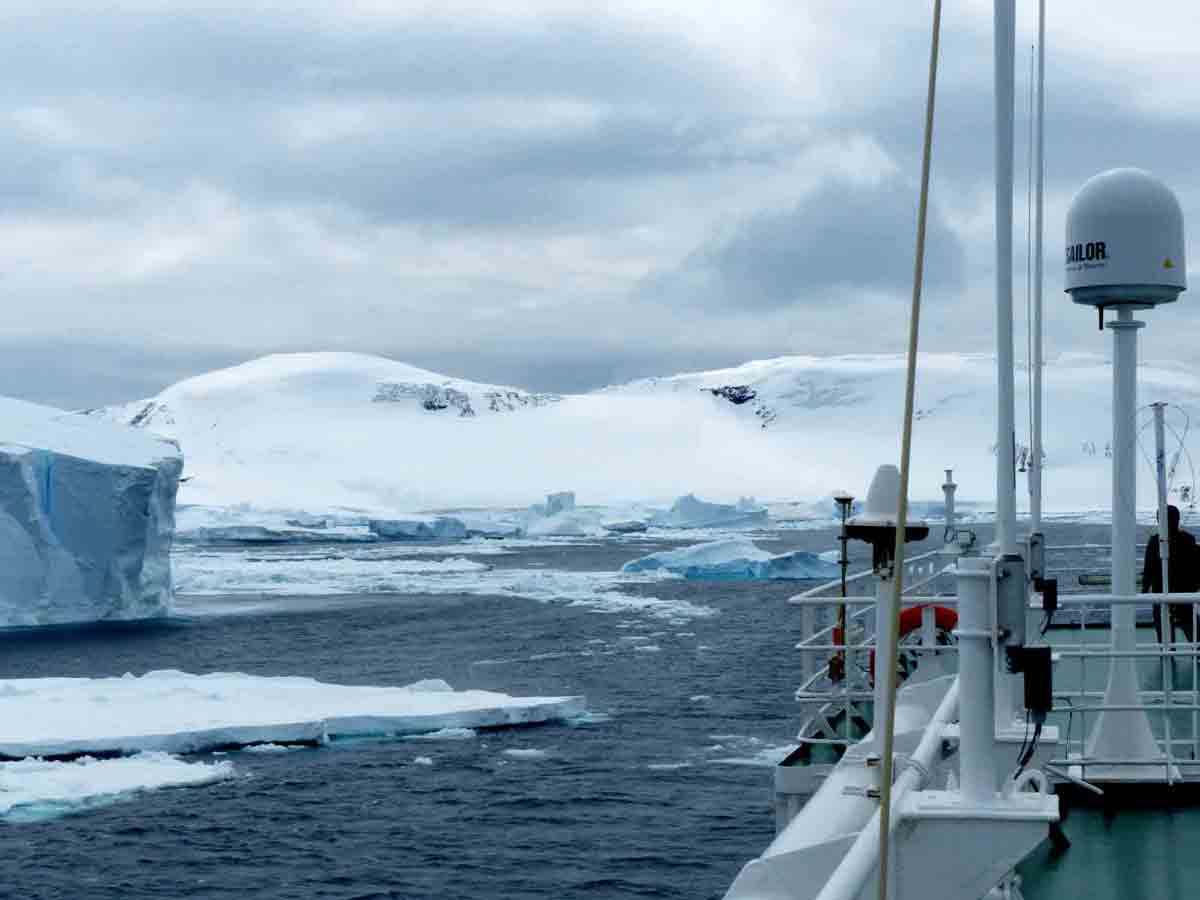
Among the icebergs and ice floes in
Antarctic Sound.

We did not see many yachts in
Antarctica!

Icebergs in Cierva Cove, on the
Antarctic Mainland
Return to Ushuaia.
To do justice to this trip
I wrote a daily diary which is far too long for delicate digestions and I
hope some will have managed to get to the end of this very abbreviated
account. We now headed directly to Cape Horn 550 nautical miles away with
a little time to digest the action packed 18 day trip. We briefly entered
the Pacific side of the Southern Ocean so that we officially rounded the Horn in
very benign conditions, and as night fell we re-entered the Beagle Channel, and
at 0630 next morning we slid quietly into Ushuaia. You could not exactly
call this trip a holiday, for it was pretty hard work and conditions for those
from temperate and tropical climes were extreme. However it was a
fantastic experience and anyone who would like to read a fuller account could
email us. We are now back in Trinidad putting the finishing touches to
Oriole's refit and having a great family Christmas with the Kelshall-Pantin
clan. We plan to leave as soon as Chris's new passport arrives which will
be around the New Year. The usual weekly blog will then recommence.
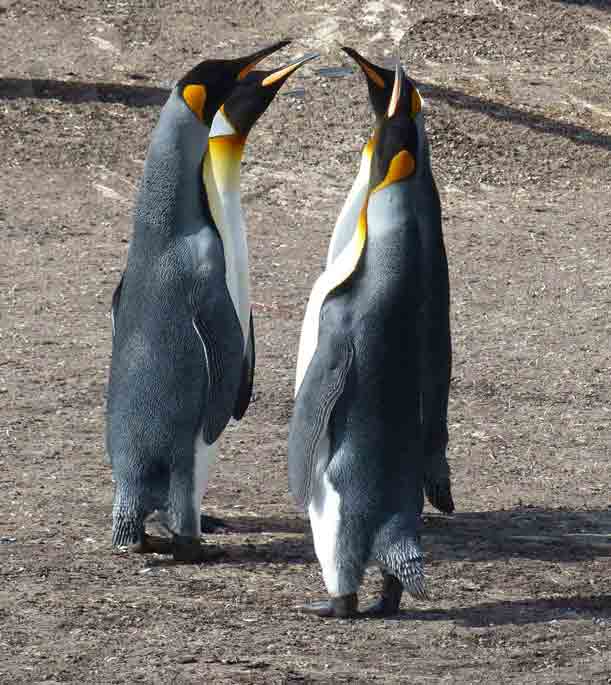
"Well guys, what shall we do for our
next trip??"